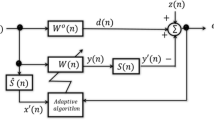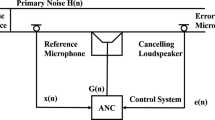Abstract
Noise can be harmful in certain situations, which leads to the need of controlling it. In general, a particular method of active noise control basically consists of creating a destructive overlap between noise and a reference signal (both with the same frequency and amplitude but with an opposite phase). Different algorithms can be used for this purpose, each of them having distinct features, like convergence, velocity, and steady state attenuation level. The convex combination method for active noise control (C-ANC) has been used successfully as it combines different characteristics of most algorithms found in literature. This method combines two distinct active noise control algorithms into a single one. For instance, it can use algorithms such as FXLMF, which has good attenuation velocity, and the FXLMS algorithm, which has a significant attenuation level. This work proposes a modified convex combination algorithm, named MC-FXLMS-F, in order to maximize the overall attenuation level. Modification of the convex combination method was implemented using the FXLMS-F algorithm. The new proposed algorithm was compared to others found in literature, such as the FXLMS, FXLMS-F, and C-FXLMS-F algorithms. The modified convex combination algorithm (MC-FXLMS-F) showed improvement in both convergence speed and attenuation level. It achieved the best performance among the most popular existing algorithms.










Similar content being viewed by others
References
Hinamoto Y, Sakai H (2007) A filtered-X LMS algorithm for sinusoidal reference signals—effects of frequency mismatch. IEEE Signal Process Lett 14(4):259–262
Kuo SM, Morgan DR (1999) Active noise control: a tutorial review. Proc IEEE 87(6):702–943
Zhang M, Lan H, Ser W (2001) Cross-updated active noise control system with online secondary path modeling. IEEE Trans Speech Audio Process 9(5):598–602
Ardekani IT, Abdulla WH (2010) Theoretical convergence analysis of FXLMS algorithm. Signal Process 90(12):3046–3055
Gaur S, Gupta VK (2016) A review on filtered-x LMS algorithm. Int J Signal Process Syst 4(2):172–176
Cheer J, Elliott SJ (2015) Multichannel control systems for the attenuation of interior road noise in vehicles. Mech Syst Signal Process 60–61:753–769
Kuo SM, Mitra S, Gan WS (2006) Active noise control system for headphone applications. IEEE Trans Control Syst Technol 14(2):331–335
Kuo SM, Morgan DR (1996) Active noise control systems: algorithms and DSP implementations. Wiley, New York
Zhang L, Tao J, Qiu X (2012) Active control of transformer noise with an internally synthesized reference signal. J Sound Vib 331(15):3466–3475
Zhao H, Zeng X, He Z, Li T (2013) Adaptive RSOV filter using the FELMS algorithm for nonlinear active noise control systems. Mech Syst Signal Process 34(1):378–392
Leahy R, Zhou Z, Hsu YC (1995) Adaptive filtering of stable processes for active attenuation of impulsive noise. In: Proceedings of the 1995 international conference on acoustics, speech, and signal processing, vol 5, pp 2983–2986
Wu L, He H, Qiu X (2011) An active impulsive noise control algorithm with logarithmic transformation. IEEE Trans Audio Speech Lang Process 19(4):1041–1044
Bjarnason E (1995) Analysis of the filtered-X LMS algorithm. IEEE Trans Speech Audio Process 3:504–514
Tobias OJ, Bermudez JCM, Bershad NJ, Seara R (1998) Mean weight behavior of the filtered-X LMS algorithm. In: IEEE International conference on acoustics, speech, and signal processing, pp 3545–3548
Tobias OJ (1999) Stochastic analysis of the filtered-X LMS algorithm. Ph.D. dissertation Federal University, Santa Catarina, Brazil
Reddy RM, Panahi IMS, Briggs R (2011) Hybrid FXRLS-FXNLMS adaptive algorithm for active noise control in fMRI application. IEEE Trans Control Syst Technol 19(2):474–480
Sun G, Li M, Lim TC (2015) A family of threshold based robust adaptive algorithms for active impulsive noise control. Appl Acoust 97:30–36
Akhtar MT, Abe M, Kawamata M (2006) A new variable step size LMS algorithm-based method for improved online secondary path modeling in active noise control systems. IEEE Trans Audio Speech Lang Process 14(2):720–726
Chang DC, Chu FT (2013) A new variable tap-length and step-size FXLMS algorithm. IEEE Signal Process Lett 20(11):1122–1125
Huang B, Xiao Y, Sun Y et al (2013) A variable step-size FXLMS algorithm for narrowband active noise control. IEEE Trans Audio Speech Lang Process 21(2):301–312
Liu W, Pokharel PP, Principe JC (2007) Correntropy: properties, and applications in non-Gaussian signal processing. IEEE Trans Signal Process 55(11):5286–5298
Lu L, Zhao H, Chen B (2016) Improved-variable-forgetting-factor recursive algorithm based on the logarithmic cost for Volterra system identification. IEEE Trans Circuits Syst II 63(6):588–592
George NV, Panda G (2012) A robust filtered-s LMS algorithm for nonlinear active noise control. Appl Acoust 73(8):836–841
Zhou Y, Zhang Q, Yin Y (2015) Active control of impulsive noise with symmetric α-stable distribution based on an improved step-size normalized adaptive algorithm. Mech Syst Signal Process 56–57:320–339
Tan L, Jiang J (2015) Active control of impulsive noise using a nonlinear companding function. Mech Syst Signal Process 58–59:29–40
Oliveira LPR, Stallaert B, Janssens K, Auweraer HV, Sas P, Desmet W (2010) NEX-LMS: a novel adaptive control scheme for harmonic sound quality control. Mech Syst Signal Process 24(6):1727–1738
Lu L, Zhao H, Chen C (2016) A normalized subband adaptive filter under minimum error entropy criterion. Signal Image Video Process 10(6):1097–1103
Chang DC, Chu FT (2014) Feedforward active noise control with a new variable tap-length and step-size filtered-X LMS algorithm. IEEE Trans Audio Speech Lang Process 22(2):542–555
Bouchard M (2003) Multichannel affine and fast affine projection algorithms for active noise control and acoustic equalization systems. IEEE Trans Speech Audio Process 11(1):54–60
Ferrer M, Diego M, Gonzalez A et al (2013) Convex combination filtered-x algorithms for active noise control systems. IEEE Trans Audio Speech Lang Process 21(1):156–167
Omour AMA, Zidouri A, Iqbal N et al (2016) Filtered-X least mean fourth (FXLMF) and leaky FXLMF adaptive algorithms. J Adv Signal Process 2016:1–20
Song P, Zhao H (2019) Filtered-x least mean square/fourth (FXLMS/F) algorithm for active noise control. Mech Syst Signal Process 120:69–82
Zhao H, Zeng X, He Z et al (2016) Improved functional link artificial neural network via convex combination for nonlinear active noise control. Appl Soft Comput 42:351–359
Akhtar MT, Mitsuhashi W (2009) Improving performance of FxLMS algorithm for active noise control of impulsive noise. J Sound Vib 327(3–5):647–656
George NV, Gonzalez A (2014) Convex combination of nonlinear adaptive filters for active noise control. Appl Acoust 76:157–161
Ferrer M, Diego M, Gonzalez A et al (2009) Convex combination of adaptive filters for ANC. In: 16th International Congress on sound and vibration, Cracow, Poland
Acknowledgements
This work was supported by the CNPq (National Council for Scientific and Technological Development) and the UFMG (Federal University of Minas Gerais).
Author information
Authors and Affiliations
Corresponding author
Additional information
Technical editor: José Roberto de França Arruda.
Publisher's Note
Springer Nature remains neutral with regard to jurisdictional claims in published maps and institutional affiliations.
Rights and permissions
About this article
Cite this article
Félix, F.B., de Castro Magalhães, M. & de Souza Papini, G. Improved active noise control algorithm based on the convex combination method. J Braz. Soc. Mech. Sci. Eng. 43, 163 (2021). https://doi.org/10.1007/s40430-021-02866-0
Received:
Accepted:
Published:
DOI: https://doi.org/10.1007/s40430-021-02866-0




